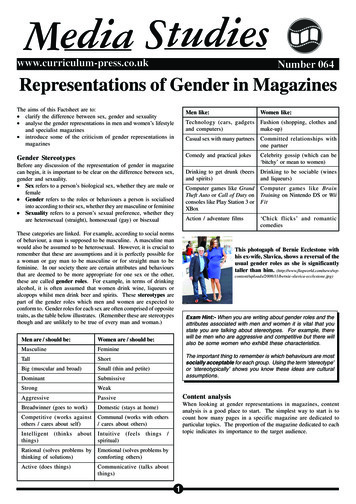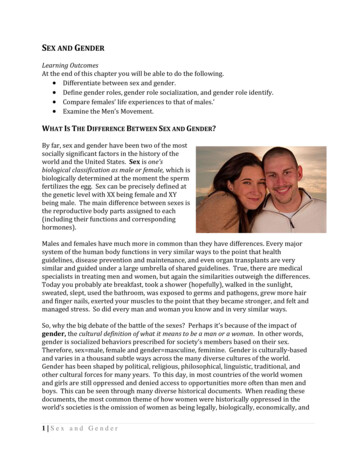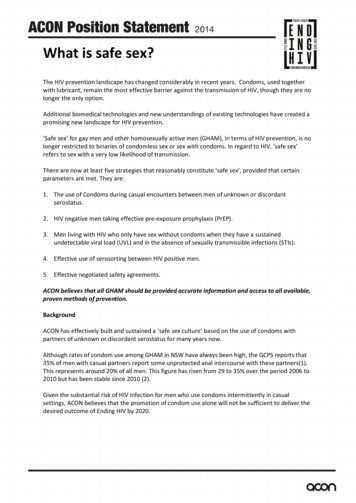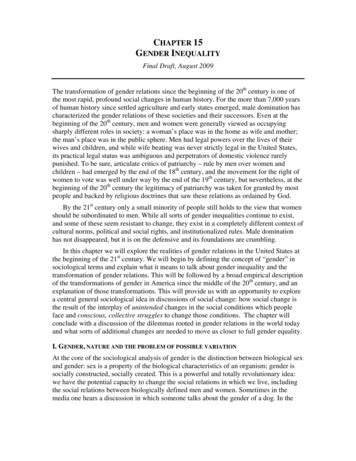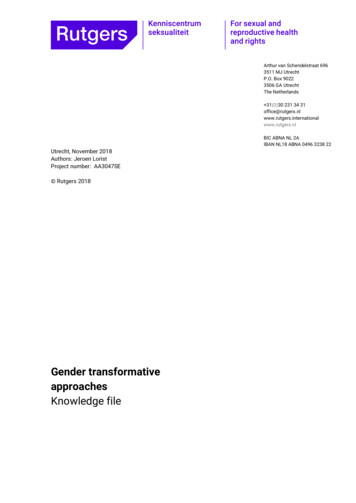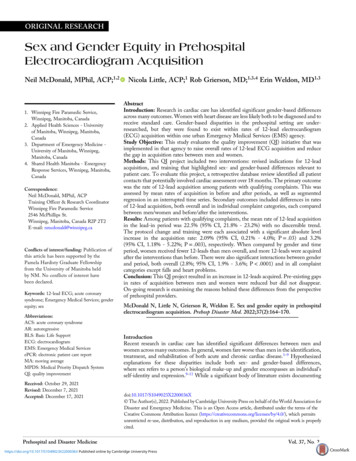
Transcription
ORIGINAL RESEARCHSex and Gender Equity in PrehospitalElectrocardiogram AcquisitionNeil McDonald, MPhil, ACP;1,21. Winnipeg Fire Paramedic Service,Winnipeg, Manitoba, Canada2. Applied Health Sciences - Universityof Manitoba, Winnipeg, Manitoba,Canada3. Department of Emergency Medicine University of Manitoba, Winnipeg,Manitoba, Canada4. Shared Health Manitoba - EmergencyResponse Services, Winnipeg, Manitoba,CanadaCorrespondence:Neil McDonald, MPhil, ACPTraining Officer & Research CoordinatorWinnipeg Fire Paramedic Service2546 McPhillips St.Winnipeg, Manitoba, Canada R2P 2T2E-mail: nmcdonald@winnipeg.caConflicts of interest/funding: Publication ofthis article has been supported by thePamela Hardisty Graduate Fellowshipfrom the University of Manitoba heldby NM. No conflicts of interest havebeen declared.Keywords: 12-lead ECG; acute coronarysyndrome; Emergency Medical Services; genderequity; sexAbbreviations:ACS: acute coronary syndromeAR: autoregressiveBLS: Basic Life SupportECG: electrocardiogramEMS: Emergency Medical ServicesePCR: electronic patient care reportMA: moving averageMPDS: Medical Priority Dispatch SystemQI: quality improvementReceived: October 29, 2021Revised: December 7, 2021Accepted: December 17, 2021Nicola Little, ACP;1 Rob Grierson, MD;1,3,4 Erin Weldon, MD1,3AbstractIntroduction: Research in cardiac care has identified significant gender-based differencesacross many outcomes. Women with heart disease are less likely both to be diagnosed and toreceive standard care. Gender-based disparities in the prehospital setting are underresearched, but they were found to exist within rates of 12-lead electrocardiogram(ECG) acquisition within one urban Emergency Medical Services (EMS) agency.Study Objective: This study evaluates the quality improvement (QI) initiative that wasimplemented in that agency to raise overall rates of 12-lead ECG acquisition and reducethe gap in acquisition rates between men and women.Methods: This QI project included two interventions: revised indications for 12-leadacquisition, and training that highlighted sex- and gender-based differences relevant topatient care. To evaluate this project, a retrospective database review identified all patientcontacts that potentially involved cardiac assessment over 18 months. The primary outcomewas the rate of 12-lead acquisition among patients with qualifying complaints. This wasassessed by mean rates of acquisition in before and after periods, as well as segmentedregression in an interrupted time series. Secondary outcomes included differences in ratesof 12-lead acquisition, both overall and in individual complaint categories, each comparedbetween men/women and before/after the interventions.Results: Among patients with qualifying complaints, the mean rate of 12-lead acquisitionin the lead-in period was 22.5% (95% CI, 21.8% - 23.2%) with no discernible trend.The protocol change and training were each associated with a significant absolute levelincrease in the acquisition rate: 2.09% (95% CI, 0.21% - 4.0%; P .03) and 3.2%(95% CI, 1.18% - 5.22%; P .003), respectively. When compared by gender and timeperiod, women received fewer 12-leads than men overall, and more 12-leads were acquiredafter the interventions than before. There were also significant interactions between genderand period, both overall (2.8%; 95% CI, 1.9% - 3.6%; P .0001) and in all complaintcategories except falls and heart problems.Conclusion: This QI project resulted in an increase in 12-leads acquired. Pre-existing gapsin rates of acquisition between men and women were reduced but did not disappear.On-going research is examining the reasons behind these differences from the perspectiveof prehospital providers.McDonald N, Little N, Grierson R, Weldon E. Sex and gender equity in prehospitalelectrocardiogram acquisition. Prehosp Disaster Med. 2022;37(2):164–170.IntroductionRecent research in cardiac care has identified significant differences between men andwomen across many outcomes. In general, women fare worse than men in the identification,treatment, and rehabilitation of both acute and chronic cardiac disease.1–9 Hypothesizedexplanations for these disparities include both sex- and gender-based differences,where sex refers to a person’s biological make-up and gender encompasses an individual’sself-identity and expression.9–11 While a significant body of literature exists documentingdoi:10.1017/S1049023X2200036X The Author(s), 2022. Published by Cambridge University Press on behalf of the World Association forDisaster and Emergency Medicine. This is an Open Access article, distributed under the terms of theCreative Commons Attribution licence (https://creativecommons.org/licenses/by/4.0/), which permitsunrestricted re-use, distribution, and reproduction in any medium, provided the original work is properlycited.Prehospital and Disaster Medicinehttps://doi.org/10.1017/S1049023X2200036X Published online by Cambridge University PressVol. 37, No. 2
McDonald, Little, Grierson, et althis phenomenon in both primary care and in-hospital settings,comparatively little research has examined these disparities inthe prehospital environment.Early identification of acute coronary syndrome (ACS) relies onthe 12-lead electrocardiogram (ECG). As with other interventions, the indications for a 12-lead have historically relied onsymptoms, especially chest pain, that were thought to be typicalfor men.12,13 Other research has emphasized the broad range ofpossible complaints beyond chest pain, such as dyspnea, alteredmental status, upper extremity pain, syncope, dizziness, weakness,abdominal pain, nausea, vomiting, falls or collapse, and confusionor delirium.14–16 Whereas these signs have been characterized as“atypical” presentations more common among women, morerecent research and commentary has questioned sex differencesin presenting symptoms in ACS and suggested that “typical”and “atypical” are themselves misnomers: signs and symptomssuggestive of ACS should be considered without reference topreconceived notions of associated sex or gender.17–19Among prehospital interventions related to ACS, the 12-lead hasbecome a standard of care in Emergency Medical Services (EMS).In many services, early identification of an ST-elevation myocardialinfarction/STEMI on a 12-lead allows crews to minimize time todefinitive treatment.20–22 Given the potential for improved outcomesfrom early recognition, treatment, and transport of ACS patients byprehospital teams, it is important to examine whether those benefitsare both optimized for all patients and distributed equitably betweenmen and women. After preliminary investigation in one EMSagency, baseline rates of ECG acquisition showed room forimprovement when compared to broad indications for assessment,and women were found to receive a 12-lead ECG less frequentlythan men across all relevant complaint categories.These findings provided the rationale for a local two-stagequality improvement (QI) project. This project aimed to increasethe rate of ECG acquisition overall and reduce the gap betweenmen and women through two interventions. First, the formalindications for 12-lead acquisition were broadened to includenon-traditional ACS symptoms. Second, this clinical and systemchange was followed by scenario-based training that highlightedpotential sex- and gender-based differences relevant to patient care.The objective of this study is to evaluate the impact of these interventions on rates of 12-lead acquisition in the prehospital setting.MethodsContextThis is a retrospective database review of all prehospital patientcontacts that potentially involved assessment for ACS beforeand after QI interventions, from January 2018 through June2019. The study took place in Winnipeg, Manitoba, a city ofapproximately 750,000 located near the east-west center ofCanada. The local service provides 9-1-1 coverage within the citylimits and responds to over 80,000 primary medical calls a year. Ituses a tiered-response model with Basic Life Support (BLS) firstresponders and mixed Basic and Advanced Life Support transportcapability. This study adheres to the Standards for QualityImprovement Reporting Excellence (SQUIRE 2.0) guidelines.23Approval for the study was granted by the affiliated HealthResearch Ethics Board (HS22981 [H2019:273]).TerminologyFollowing other research in this area, this study refers to a person’sbiological make-up as “sex” and their individual self-identity andApril 2022https://doi.org/10.1017/S1049023X2200036X Published online by Cambridge University Press165Revised ProtocolStudy InclusionAge Category12-Lead Indicatedwith PresentingComplaintsMPDS Category,Number 30Chest PainChest Pain, 10Heart Problems, 19 50Short of BreathShort of Breath, 6SyncopeSyncope, 31Altered Mental Status General Illness, 26WeaknessFalls, 17Upper Extremity Pain 70Abdominal PainAllAny Significant RiskFactors or PoorImpressionAbdominal Pain, 1McDonald 2022 Prehospital and Disaster MedicineTable 1. Revised Protocol Indications for 12-Lead Acquisitionand Study Inclusion Criteriaexpression as “gender.”10,11 Both concepts have been describedas relevant to a patient’s risk for ACS and presentation tohealth care providers with signs and symptoms that warrantinvestigation.9–11 Accordingly, in-service training on presentingsigns and symptoms included information on both sex and gender.However, the documentation platform in use during the studyperiod (RescueNet; ZOLL Medical; Chelmsford, MassachusettsUSA) recorded “gender” but offered only a choice between maleand female for a required response, a common limitation of datasystems.24 In practice, front-line providers take in a variety of information and cues to complete this field, including how patients referto and present themselves, how bystanders and family refer to thepatient, observed patient characteristics, and how patient information is recorded in the provincial health care database.Acknowledging a lack of non-binary options as well as limitedtraining in this area,24,25 and in common with similar studies,26 thispaper will use the term gender (woman, man) to describe howpatients are documented in the case of potential ACS calls. It willfollow terms in print when referring to other studies.InterventionsInitial tests of change and iterative discovery of the normssurrounding 12-lead acquisition identified knowledge gaps amongfrontline staff and specific areas for improvement. The resulting QIinterventions aimed to remove inconsistencies in crews’ understanding of both the indications for and timing of 12-lead acquisition, and to encourage BLS first responders to proceed withassessment when indicated. The first intervention added revisedindications for 12-lead acquisition to the ACS protocol in July2018 (Table 1). These revisions were written by the ServiceQuality Branch under the supervision of the service’s medical directors and drawn from published research on the topic. Up until thattime, the ACS protocol listed chest pain as the sole indication for a12-lead ECG; in practice, all providers could interpret indicationsmore or less broadly depending on their qualification level, timesince training, experience, and personal knowledge. The secondintervention occurred in the fall of 2018 and consisted of in-person,scenario-based training provided to BLS first responders toemphasize sex- and gender-based factors relevant to patient care.Lasting one or two hours, these small-group sessions were ledPrehospital and Disaster Medicine
166by a clinical leader and were based on training scenarios drawn fromprior cases identified by the Service Quality team. This trainingperiod lasted eight weeks. The time periods before the protocolchange and after the end of training were each approximately sixmonths.MeasuresIn the absence of any established method for retrospectively identifying prehospital patients who require a 12-lead, this study usedthe broad complaints listed in the revised protocol as the basis forinclusion (Table 1). Patient complaints were identified in the database of electronic patient care reports (ePCRs) by matching themwith the closest corresponding dispatch code under the MedicalPriority Dispatch System (MPDS; Salt Lake City, Utah USA);these codes are also listed in Table 1. Cases matching age anddispatch-code criteria were included; those that did not wereexcluded. Due to the broad categorization of complaint, thismethod would be expected to over-count the number of eligiblepatients (the denominator), and therefore under-estimate ratesof acquisition among those at risk for ACS. It would, however,capture the broadest sample of eligible patients and provide reliableestimates of change over time – both of which are consistent withthe study objective. In the local service, all medical 9-1-1 calls areassigned an MPDS code (with the exception of those transferreddirectly from police). The ePCR records of eligible patients werereviewed for documentation of a 12-lead ECG. Frontline crewsrecord 12-lead acquisition either by clicking on an interventionbutton in the documentation software or by uploading data fromthe cardiac monitor. There is no way to retrospectively assess missingness in 12-lead documentation, but practice norms discussed bycrews during the initial stages of the project suggest it is exceedinglyrare to complete a 12-lead and not document it; if present, missingness would bias results towards lower rates of acquisition.Outcomes and AnalysisThe primary outcome was the rate of 12-lead acquisition amongpatients with qualifying complaints. Secondary outcomes includeddifferences in rates of 12-lead acquisition both overall and in individual MPDS complaint categories, each compared between men/women and before/after the interventions.In the case of the primary outcome, rates of 12-lead acquisitionwere calculated for the before and after periods (mean, 95% CI) andalso analyzed by segmented regression in an interrupted time series.The use of an interrupted time series analysis for the primaryoutcome has several benefits over a simple before-and-aftercomparison. Considered the most robust of quasi-experimentalapproaches,27 an interrupted time series can account for underlyingtrends in data, estimate the effect of each intervention, and gaugethe staying-power of effects over time – all benefits particularlyrelevant to this project. Data were plotted on a weekly basis over78 weeks, with a mean of 778 observations per week. Segmentswere defined by the implementation of the new protocol (betweenweeks 26 and 27) and the in-service training that occurred duringweeks 48 - 55. Given gradual accumulation of trained providersand small number of observations over the training period, datawithin this time were censored, and level and trend changes werecalculated between the beginning and end of the training.28After an initial model was fit, autocorrelation was assessed usingplots of the autocorrelation and partial autocorrelation functionsas well as the Durbin-Watson test of residuals. The model was thenre-specified with candidate autoregressive (AR) or moving averagePrehospital and Disaster Medicinehttps://doi.org/10.1017/S1049023X2200036X Published online by Cambridge University PressSex and Gender in Prehospital ECG Acquisition(MA) terms. Initial testing identified three models for comparison:no AR or MA terms, AR(p) 5, and AR(p) 7. The model withno terms was shown to have the best fit (resulting Durbin-Watsontest of residuals: 1.77; P .057). No effect of seasonality was anticipated or modelled.Secondary outcomes were analyzed in terms of mean rates of12-lead acquisition before and after training. In each analysis, alleligible cases were included in a linear model with time periodand gender as predictor variables (main effects and interaction).Results were considered statistically significant at alpha 0.05.All analysis was performed in R, version 4.0.4 (Foundation forStatistical Computing; Vienna, Austria).ResultsPrimary Outcome: 12-Lead Acquisition among Patients withQualifying ComplaintsIn the lead-in period prior to the protocol change, the mean rate of12-lead acquisition among patients with qualifying complaints was22.5% (95% CI, 21.8% - 23.2%). After training until the end of thestudy period, the mean rate was 27.2% (95% CI, 26.5% - 27.9%).The interrupted time series for 12-lead acquisition among thisgroup is summarized in Figure 1. Of note, each intervention wasassociated with a significant absolute level increase in the acquisition rate. In the case of the revised protocol, this change was 2.09%(95% CI, 0.21% - 4.0%; P .03); for the end of the scenario-basedtraining period, it was 3.2% (95% CI, 1.18% - 5.22%; P .003).In the six-month period after the additional training until thestudy end, the rate of 12-lead acquisition showed a non-significantrelative decrease of 0.15% per week (95% CI, 0.3% to 0.003%;P .06).Secondary Outcome: Effects of Period and Genderon Acquisition RatesTable 2 summarizes the differences in acquisition rates betweenperiod and gender. There were significant main effects for bothfactors: 12-leads were acquired more often in the period aftertraining in most categories (except syncope and abdominal pain),and they were acquired less often in women than men in all. Thesignificant positive interactions illustrated the additional combinedeffect of period and gender: rate increases in the after period weregreater among women than men, both overall (2.8%; 95% CI, 1.9%- 3.6%; P .0001) and in all complaint categories except falls andheart problems. In the case of falls, the negative interaction termindicated a greater effect among men ( 2.3%; 95% CI, 2.5%to 2.0%; P .0001), whereas a non-significant finding amongheart problems showed no additional change beyond the maineffects of period and gender (1.6%; 95% CI, 2.0% to 5.3%;P .38). These results are shown graphically in Figure 2 in termsof mean rates of 12-lead acquisition among men and women in thebefore and after periods. In most cases, the difference between menand women narrowed, while it widened in the case of falls andstayed the same in heart problems. This figure also illustratesthe relative contribution of each factor. In the cases of syncopeand abdominal pain, for example, the decreasing rate of acquisitionamong men contributed to the narrowing difference between menand women.DiscussionWithin this urban EMS agency, the introduction of a revisedprotocol and follow-up training were both associated with modestincreases in the rate of 12-lead ECG acquisition among patientswith qualifying complaints. Within these findings, differences inVol. 37, No. 2
McDonald, Little, Grierson, et alComplaint167Main EffectsInteractionCandidates forPeriodGenderAssessment (Count) (After minus Before) (Women minus Men)Additional Change in Rate due to CombinedEffect of Period and Gendera(Women, After minus Men, Before)370683.2 (2.6, 3.9) 8.1 ( 8.7, 7.4)2.8 (1.9, 3.6)Chest Pain51884.4 (3.9, 4.9) 8.8 ( 9.3, 8.4)2 (1.3, 2.7)Heart Problems11147.8 (5.1, 10.6) 13 ( 15.5, 10.6)Syncope4358 4.7 ( 5.3, 4.1)Short of Breath5582All Complaints8.4 (8, 8.8)1.6 ( 2, 5.3)b 6.9 ( 7.6, 6.3)6 (5.1, 6.9) 8.9 ( 9.3, 8.6)3 (2.5, 3.5)Abdominal Pain1992 2.0 ( 3, 1.1) 9.5 ( 10.3, 8.6)6.3 (5.1, 7.4)General Illness103422.1 (1.9, 2.2) 4.2 ( 4.4, 4.1)1.8 (1.5, 2)84927.7 (1.5, 7.9) 3.6 ( 3.8, 3.4)Falls 2.3 ( 2.5, 2)McDonald 2022 Prehospital and Disaster MedicineTable 2. Percent Differences in Rates of 12-Lead Acquisition, by Period and GenderNote: All percent difference values 95% CI.aPositive interactions indicate increased rates among Women in the After period compared to Men, Before.bAssociated P value .38. All others .0001.McDonald 2022 Prehospital and Disaster MedicineFigure 1. Interrupted Time Series of 12-Lead Acquisition among Patients with Qualifying Complaints.Note: Weekly data from January 2018 through June 2019 (78 weeks), with interventions and study periods as marked. Values abovethe chart show absolute level changes associated with each intervention. Values below correspond to trend changes during eachstudy period relative to the period before.rates of ECG acquisition between women and men in mostcomplaint categories were reduced but not eliminated in the timeperiod after the QI interventions. In line with an increasing numberof studies that interrogate a wide range of health care settings andpractitioners for unconscious bias,29–31 the current study wasdesigned to illuminate a previously unexamined area of practice.The results presented here showing a persistent gender gap obligeproviders in this service to reflect on their choices and confronttheir assumptions in these specific situations. They also encouragethe same elsewhere. These data amount to a powerful trainingApril 2022https://doi.org/10.1017/S1049023X2200036X Published online by Cambridge University Presstool that does more than simply confirm that differences in careexist: it exposes unconscious bias so that it can be consciouslyaddressed.This study’s findings align with the limited data on genderdifferences in 12-lead acquisition in prehospital care. One recentretrospective database study of patients with diagnosed myocardialinfarctions from Australia found 12% lower odds for womenreceiving a prehospital 12-lead as compared to men (OR: 0.88;95% CI, 0.83 0.92).32 An unpublished master’s thesis fromNew Zealand also reported significantly lower odds for womenPrehospital and Disaster Medicine
168Sex and Gender in Prehospital ECG AcquisitionMcDonald 2022 Prehospital and Disaster MedicineFigure 2. Mean Rates of 12-Lead Acquisition.Note: Percent mean rates of acquisition (all Y axes), before and after interventions, in both all complaints and individual categories.Error bars denote 95% confidence intervals.(adjusted OR: 0.50; 95% CI, 0.40 - 0.63).33 The latter studyreported the rates of acquisition (men: 49.6%; women: 34.1%),but patients were included only if presenting with complaints ofchest pain and treated with a working diagnosis of ACS byattending paramedics.33 While acknowledging differences inmethods, geography, and time, the results of the current study(where at least 60% of patients with chest pain received a 12-lead)are comparable when considered on similar terms. Overall rates ofacquisition among patients with qualifying complaints (reportedhere in the range of 20% - 30%), while relatively low, shouldbe interpreted in the context of this study’s aim and design.The QI project sought to increase rates of acquisition using thebroadest indications for assessment, acknowledging that measuredoutcomes will over-count cases where ACS was considered andtherefore under-estimate acquisition rates among those assessed.Under these conditions, the results nevertheless show significantimprovement. Additionally, the methods of inclusion (particularlyusing MPDS criteria) establish a consistent and reproducible basisfor comparison that could be applied in any service using the samesystem.To the authors’ knowledge, no prior studies have analyzed ratesof ECG acquisition in terms of presenting complaints other thanchest pain. The complaint-based analysis here shows variable ratesof acquisition. However, the relevance of these results lies in thechanges within each complaint over time rather than the absoluterates compared across categories: it is unsurprising that 12-leadswere acquired more often in cases that were dispatched as chestpain calls as compared to general illness. Results for each complainthave therefore been presented individually. These findings signalstrongly both that rates improved after training and that the gendergap decreased but did not disappear. There is no obvious explanation for the decreased rates of acquisition among men in callsPrehospital and Disaster Medicinehttps://doi.org/10.1017/S1049023X2200036X Published online by Cambridge University Presscoded as syncope and abdominal pain. Results in these areascontinue to be monitored.Other relevant literature in this area includes a range of studiesthat have examined out-of-hospital cardiac arrest/OHCA in termsof gender. Many of these report that women receive standardinterventions less often or later as compared to men.9,26,34–36In a North American context, some of these studies have confirmedthat women are resuscitated or survive to discharge lessfrequently,26,34,36,37 although these findings have not been seenin other settings in Europe.38,39 A QI project in North Carolina(USA) reported decreased differences in many interventions (suchas bystander cardiopulmonary resuscitation) between genders, butdid not see those effects translated to outcomes.36The results presented here can be placed in the context of thegoals of the QI project and the local system. At its outset, theproject aimed to increase the percentage of patients with possibleACS who receive a 12-1ead ECG to 50% within 12 months.This goal was not met. In the absence of prior literature anddetailed knowledge of ideal rates of acquisition (either overall orin particular complaint categories), the initial target was admittedlyarbitrary. Having quantified outcomes in this study, future workcould potentially target more relevant and achievable thresholdsbased on specific complaints. This project also faced additionalobstacles common to many QI initiatives in EMS.40 These includechronic challenges in balancing training with operational demands,as well as resource limitations in the available training time andpersonnel.Although the improvements did not reach the pre-specifiedgoal, the observed increases after the interventions representapproximately 36 additional patients per week who received a12-lead, with more women being assessed in most categories thanpreviously. Results of this project have been distributed within theVol. 37, No. 2
McDonald, Little, Grierson, et alservice and incorporated into regular training. Rates of acquisitioncontinue to be monitored, and additional qualitative researchexamining provider attitudes towards gender and 12-leadacquisition is on-going. Finally, in these results, the rates ofECG acquisition in both the lead-in and between-interventionsperiods showed no appreciable trend, increasing the confidencein the effect of the interventions. At the same time, althoughthe decreasing trend in the period after training did not reach statistical significance, it is unlikely that there would be no decay ifobserved over a longer time. Comparing these trends suggeststhe possibility that the effect of changing a written protocol persistsfor longer than in-person training. While many factors contributeto knowledge decay, it might be possible to maximize practicechange by structuring a QI initiative around in-person trainingfollowed by supporting changes to guidelines. This hypothesisshould be investigated further in future QI efforts.LimitationsThis study is subject to some limitations. The main objective of thestudy was to assess ECG acquisition rates before and after a QIinitiative aimed at inclusivity in prehospital care. The study designlimits any interpretation of actual clinical outcomes associated withincreased identification of potential ACS cases and 12-lead interpretation. As discussed previously, the wealth of hospital literatureReferences1. Araujo C, Pereira M, Laszczynska O, Dias P, Azevedo A. Sex-related inequalities inmanagement of patients with acute coronary syndrome-results from the EURHOBOPstudy. Int J Clin Pract. 2018;72(1).2. Choi J, Daskalopoulou SS, Thanassoulis G, et al. Sex- and gender-related risk factorburden in patients with premature acute coronary syndrome. Can J Cardiol. 2014;30(1):109–117.3. Dreyer RP, Smolderen KG, Strait KM, et al. Gender differences in pre-event healthstatus of young patients with acute myocardial infarction: a VIRGO study analysis. EurHeart J Acute Cardiovasc Care. 2016;5(1):43–54.4. Garcia M, Mulvagh SL, Merz CN, Buring JE, Manson JE. Cardiovascular disease inwomen: clinical perspectives. Circ Res. 2016;118(8):1273–1293.5. Guo Y, Yin F, Fan C, Wang Z. Gender difference in clinical outcomes of the patientswith coronary artery disease after percutaneous coronary intervention: a systematicreview and meta-analysis. Medicine (Baltimore). 2018;97(30):e11644.6. Smilowitz NR, Mahajan AM, Roe MT, et al. Mortality of myocardial infarction by sex,age, and obstructive coronary artery disease status in the ACTION Registry-GWTG(Acute Coronary Treatment and Intervention Outcomes Network Registry-Get withthe Guidelines). Circ Cardiovasc Qual Outcomes. 2017;10(12):e003443.7. Udell JA, Fonarow GC, Maddox TM, et al. Sustained sex-based treatment differences inacute coronary syndrome care: insights from the American Heart Association Get withthe Guidelines Coronary Artery Disease Registry. Clin Cardiol. 2018;41(6):758–768.8. Mnatzaganian G, Hiller JE, Braitberg G, et al. Sex disparities in the assessment andoutcomes of chest pain presentations in emergency departments. Heart. 2020;106(2):111–118.9. Jarman AF, Mumma BE, Perman SM, Kotini-Shah P, McGregor AJ. Whenthe female heart stops: sex and gender differences in out-of-hospital cardiac arrestepidemiology and resuscitation. Clin Ther. 2019;41(6):1013–1019.10. Connelly PJ, Azizi Z, Alipour P, Delles C, Pilote L, Raparelli V. The importance ofgender to understand sex differences in cardiovascular disease. Can J Cardiol. 2021;37(5):699–710.11. O’Neil A, Scovelle AJ, Milner AJ, Kavanagh A. Gender/sex as a social determinant ofcardiovascular risk. Circulation. 2018;137(8):854–864.12. Lichtman JH, Leifheit EC, Safdar B, et al. Sex differences in the presentation andperception of symptoms among young patients with myocardial infarction: evidencefrom the VIRGO Study (Variation in Recovery: Role of Gender on Outcomes ofYoung AMI Patients). Circulation. 2018;137(8):781–790.13. Canto JG, Shlipak MG, Rogers WJ, et al. Prevalence, clinical characteristics, andmortality among patie
period (RescueNet; ZOLL Medical; Chelmsford, Massachusetts USA) recorded "gender" but offered only a choice between male and female for a required response, a common limitation of data . The ePCR records of eligible patients were reviewed for documentation of a 12-lead ECG. Frontline crews
